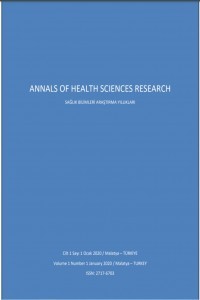Kronik Akciğer Hastalıklarında İlaç Geliştirme ve Güncel Tedavi Stratejileri
Akciğer Hastalıkları, Kronik Hastalık, İlaç Keşfi
Drug Development and Current Treatment Strategies in Chronic Lung Diseases
Lung Diseases, Chronic Disease, Drug Discovery,
___
- Bousquet J, Khaltaev N, eds. Global surveillance, prevention and control of chronic respiratory diseases a comprehensive approach. Switzerland: WHO Press 2007: 12-35.
- Gibson GJ, Loddenkemper R, Sibille Y, Lundbäck B, eds. The European Lung White Book: Respiratory Health and Disease in Europe. Sheffield, European Respiratory Society, 2013.
- Partridge MR, van der Molen T, Myrseth SE, Busse WW. Attitudes and actions of asthma patients on regular maintenance therapy: the INSPIRE study. BMC Pulm Med 2006; 6: 13.
- Barnes PJ, Bonini S, Seeger W, et al. Barriers to new drug development in respiratory disease. Eur Respir J 2015; 45(5): 1197-207.
- Visiongain. Asthma and COPD Therapies: World Market www.visiongain.com/Report/1109/ Asthma-and- COPD-Therapies-World-Market-2013-2023. Son Erişim: 15 Ocak 2018. 2013–2023.
- Kakkar AK, Dahiya N. Bedaquiline for the treatment of resistant tuberculosis: promises and pitfalls. Tuberculosis 2014; 94: 357-62.
- Kola I, Landis J. Can the pharmaceutical industry reduce attrition rates? Nat Rev Drug Disc 2004; 3: 711-15.
- Arrowsmith J, Miller P. Trial watch: phase II and phase III attrition rates 2011-2012. Nat Rev Drug Disc 2013; 12: 569.
- Wehling M. Assessing the translatability of drug projects: what needs to be scored to predict success? Nat Rev Drug Discov 2009; 8: 541-46.
- Southan C, Williams AJ, Ekins S. Challenges and recommendations for obtaining chemical structures of industry-provided repurposing candidates. Drug Discov Today 2013; 18: 58-70.
- Tobinick EL. The value of drug repositioning in the current pharmaceutical market. Drug News Perspect 2009; 22: 119 -25.
- Barnes PJ. Theophylline. Am J Respir Crit Care Med 2013; 188: 901-6.
- To Y, Ito K, Kizawa Y, et al. Targeting phosphoinositide-3-kinase-δ with theophylline reverses corticosteroid insensitivity in COPD. Am J Resp Crit Care Med 2010; 182: 897-904.
- Holmes AM, Solari R, Holgate ST. Animal models of asthma: value, limitations and opportunities for alternative approaches. Drug Discov Today 2011; 16: 659-70.
- Sun T, Swindle EJ, Collins JE, et al. On-chip epithelial barrier function assays using electrical impedance spectroscopy. Lab Chip 2010; 10: 1611-7.
- Swindle EJ, Davies DE. Artificial airways for the study of respiratory disease. Expert Rev Respir Med 2011; 5: 757-65.
- Morris GE, Bridge JC, Brace LA, et al. A novel electrospun biphasic scaffold provides optimal three-dimensional topography for in vitro co- culture of airway epithelial and fibroblast cells. Biofabrication 2014; 6(3): 035014.
- Morris GE, Bridge JC, Eltboli OM, et al. Human airway smooth muscle maintain in situ cell orientation and phenotype when cultured on aligned electrospun scaffolds. Am J Physiol Lung Cell Mol Physiol 2014; 307: 38-47.
- Huh D, Matthews BD, Mammoto A, et al. Reconstituting organ-level lung functions on a chip. Science 2010; 328: 1662-8.
- Huh D, Leslie DC, Matthews BD, et al. A human disease model of drug toxicity-induced pulmonary edema in a lung-on-a-chip microdevice. Sci Transl Med 2012; 4: 159ra147.
- Huh D, Fujioka H, Tung YC, et al. Acoustically detectable cellular-level lung injury induced by fluid mechanical stresses in microfluidic airway systems. Proc Nat Acad Sci USA 2007; 104: 18886-91.
- Mercer PF, Abbott-Banner K, Adcock IM, Knowles RG. Translational models of lung disease. Clin Sci (Lond) 2015; 128: 235–56.
- Marios AM, Aidinis V. Modeling pulmonary fibrosis with bleomycin. Curr Opin Pulm Med 2011; 17: 355-61.
- Ermis H, Parlakpinar H, Gulbas G, et al. Protective effect of dexpanthenol on bleomycin- induced pulmonary fibrosis in rats. Naunyn Schmiedebergs Arch Pharmacol 2013; 386(12): 1103-10.
- Kilic T, Parlakpinar H, Polat A, et al. Protective and therapeutic effect of molsidomine on bleomycin-induced lung fibrosis in rats. Inflammation 2014; 37(4): 1167-78.
- Kilic T, Parlakpinar H, Taslidere E, et al. Protective and therapeutic effect of apocynin on bleomycin-induced lung fibrosis in rats. Inflammation 2015; 38(3): 1166-80.
- Shakshuki A, Agu RU. Improving the efficiency of respiratory drug delivery: a review of current treatment trends and future strategies for asthma and chronic obstructive pulmonary disease. Pulm Ther 2017; 3(2): 267-81.
- Başlangıç: 2012
- Yayıncı: İnönü Üniversitesi
Akut Miyokard İnfarktüsü Geçiren Hastalara Psikososyal Yaklaşım
Nurcan UZDİL, Ozlem CEYHAN, Nuray SİMSEK
Rat Modelinde Laminektomi Sonrası Epidural Fibrozisin Topikal Aminoguanidin Kullanılarak İnhibisyonu
Hemşirelik Öğrencilerinin Yaz Okulu Hakkındaki Görüşleri
Rukuye AYLAZ, Nurdan ÇETİN, Gülsüm YETİŞ
Biyoelektrik İmpedans Analizi Parametrelerinden Faz Açısının, Tanısal Kriter Olarak Olası Rolü
Çocuklarda Davranım Bozukluğu: Olgu Sunumu
Ramazan Fazıl AKKOÇ, Elif ERDEM, Nalan KAYA, Gonca OZAN, Durrin Özlem DABAK, İbrahim Enver OZAN
Kronik Akciğer Hastalıklarında İlaç Geliştirme ve Güncel Tedavi Stratejileri
Onural ÖZHAN, Hakan PARLAKPINAR
Sağlık Personelinin Kadına Yönelik Şiddet Konusunda Deneyimleri ve Şiddeti Tanıyabilme Düzeyleri
Gülsen GÜNEŞ, Meryem SARIBIYIK, Çiğdem TEKİN
Türkiye'deki Mültecilere Transkültürel Hemşirelik Yaklaşımı
Seher TANRIVERDİ, Neslihan SOYLEMEZ, Celebi DİLEKCİ
